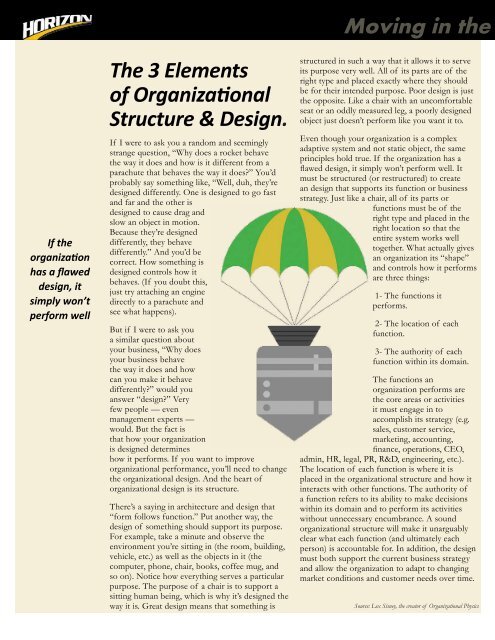Winter 2018
Create successful ePaper yourself
Turn your PDF publications into a flip-book with our unique Google optimized e-Paper software.
Moving in the Right Direction<br />
HorizonNEWS<br />
If the<br />
organization<br />
has a flawed<br />
design, it<br />
simply won’t<br />
perform well<br />
The 3 Elements<br />
of Organizational<br />
Structure & Design.<br />
If I were to ask you a random and seemingly<br />
strange question, “Why does a rocket behave<br />
the way it does and how is it different from a<br />
parachute that behaves the way it does?” You’d<br />
probably say something like, “Well, duh, they’re<br />
designed differently. One is designed to go fast<br />
and far and the other is<br />
designed to cause drag and<br />
slow an object in motion.<br />
Because they’re designed<br />
differently, they behave<br />
differently.” And you’d be<br />
correct. How something is<br />
designed controls how it<br />
behaves. (If you doubt this,<br />
just try attaching an engine<br />
directly to a parachute and<br />
see what happens).<br />
But if I were to ask you<br />
a similar question about<br />
your business, “Why does<br />
your business behave<br />
the way it does and how<br />
can you make it behave<br />
differently?” would you<br />
answer “design?” Very<br />
few people — even<br />
management experts —<br />
would. But the fact is<br />
that how your organization<br />
is designed determines<br />
how it performs. If you want to improve<br />
organizational performance, you’ll need to change<br />
the organizational design. And the heart of<br />
organizational design is its structure.<br />
There’s a saying in architecture and design that<br />
“form follows function.” Put another way, the<br />
design of something should support its purpose.<br />
For example, take a minute and observe the<br />
environment you’re sitting in (the room, building,<br />
vehicle, etc.) as well as the objects in it (the<br />
computer, phone, chair, books, coffee mug, and<br />
so on). Notice how everything serves a particular<br />
purpose. The purpose of a chair is to support a<br />
sitting human being, which is why it’s designed the<br />
way it is. Great design means that something is<br />
structured in such a way that it allows it to serve<br />
its purpose very well. All of its parts are of the<br />
right type and placed exactly where they should<br />
be for their intended purpose. Poor design is just<br />
the opposite. Like a chair with an uncomfortable<br />
seat or an oddly measured leg, a poorly designed<br />
object just doesn’t perform like you want it to.<br />
Even though your organization is a complex<br />
adaptive system and not static object, the same<br />
principles hold true. If the organization has a<br />
flawed design, it simply won’t perform well. It<br />
must be structured (or restructured) to create<br />
an design that supports its function or business<br />
strategy. Just like a chair, all of its parts or<br />
functions must be of the<br />
right type and placed in the<br />
right location so that the<br />
entire system works well<br />
together. What actually gives<br />
an organization its “shape”<br />
and controls how it performs<br />
are three things:<br />
1- The functions it<br />
performs.<br />
2- The location of each<br />
function.<br />
3- The authority of each<br />
function within its domain.<br />
The functions an<br />
organization performs are<br />
the core areas or activities<br />
it must engage in to<br />
accomplish its strategy (e.g.<br />
sales, customer service,<br />
marketing, accounting,<br />
finance, operations, CEO,<br />
admin, HR, legal, PR, R&D, engineering, etc.).<br />
The location of each function is where it is<br />
placed in the organizational structure and how it<br />
interacts with other functions. The authority of<br />
a function refers to its ability to make decisions<br />
within its domain and to perform its activities<br />
without unnecessary encumbrance. A sound<br />
organizational structure will make it unarguably<br />
clear what each function (and ultimately each<br />
person) is accountable for. In addition, the design<br />
must both support the current business strategy<br />
and allow the organization to adapt to changing<br />
market conditions and customer needs over time.<br />
Source: Lex Sisney, the creator of Organizational Physics<br />
Examine<br />
your pricing<br />
objectives<br />
to develop<br />
a clear idea<br />
of what<br />
you want<br />
your pricing<br />
strategy to<br />
achieve.<br />
HorizonNEWS<br />
Four Types of<br />
Pricing Strategies<br />
Setting prices for your products or services<br />
doesn't simply come down to a simple<br />
calculation. Prices can be practical tools for<br />
making ends meet or they can be marketing<br />
tactics for communicating something about<br />
the quality of your offerings. To figure out the<br />
best way to set prices, it's worthwhile to take a<br />
step back and examine your pricing objectives<br />
to develop a clear idea of what you want your<br />
pricing strategy to achieve.<br />
Profit-Oriented Pricing<br />
In a sense, all pricing is<br />
profit-oriented because,<br />
even if you set prices<br />
with other objectives<br />
in mind, you still need<br />
to earn a profit to stay<br />
in business. However,<br />
profit-oriented pricing<br />
makes profit the top<br />
priority when figuring<br />
out the ideal price to<br />
set. A profit-oriented<br />
pricing strategy looks<br />
for the sweet spot that<br />
allows you to charge<br />
as much as possible<br />
for your offerings without charging so much<br />
that you alienate potential customers and lose<br />
money through missed sales. This type of<br />
pricing objective can either aim to maximize<br />
profit per unit relative to cost of goods sold<br />
and other operating costs, or it can aim to<br />
maximize overall profit by setting a price that<br />
is competitive enough to increase the overall<br />
number of units you sell.<br />
Competitor-Based Pricing<br />
Competitor-based pricing uses the price you<br />
set to appeal to customers and define your<br />
niche relative to your competitors. It doesn't<br />
necessarily rely on setting a lower price than<br />
other available options, although this strategy<br />
will certainly make your products appeal to<br />
customers who shop on the basis of price alone.<br />
You can also use competitor-based pricing<br />
effectively by setting a price that's in the same<br />
ballpark as other products in the same niche, or<br />
by choosing a higher price to send the message<br />
that your product is superior and worth the<br />
extra money.<br />
Market Penetration<br />
A market penetration pricing strategy is geared<br />
towards getting a foothold in a competitive<br />
market, usually by offering a low initial price.<br />
If you start out by attracting customers on<br />
the basis of price, you can get more people<br />
to try your products, and then start building a<br />
reputation and clientele that will allow you to<br />
eventually charge more.<br />
A market penetration<br />
strategy can be risky<br />
because customers don't<br />
like growing accustomed<br />
to a low price and then<br />
being asked to pay more.<br />
However, this approach<br />
can be successful if your<br />
products really do have<br />
qualities other than price<br />
that will make customers<br />
want to buy them, such<br />
as unique features or<br />
unusually high quality.<br />
Skimming<br />
A skimming pricing strategy uses the opposite<br />
logic from one based on market penetration.<br />
Although market penetration uses low prices<br />
to attract attention, skimming uses a reputation<br />
that has already been built to charge high prices<br />
from early adopters. If customers are passionate<br />
about your products and willing to pay extra to<br />
be the first to have them, you can charge initial<br />
high prices when you first introduce a new<br />
innovation or a new line, and then lower the<br />
prices once you've already attracted the people<br />
who are willing to pay more.<br />
Source: Devra Gartenstein<br />
HorizonNews is published by Horizon Transportation issued every quarter to improve communication in the Produce Industry.<br />
Publisher: Thomas Leal Design: Business Spring Communications - www.b-spring.com, tel (559) 801 2090




